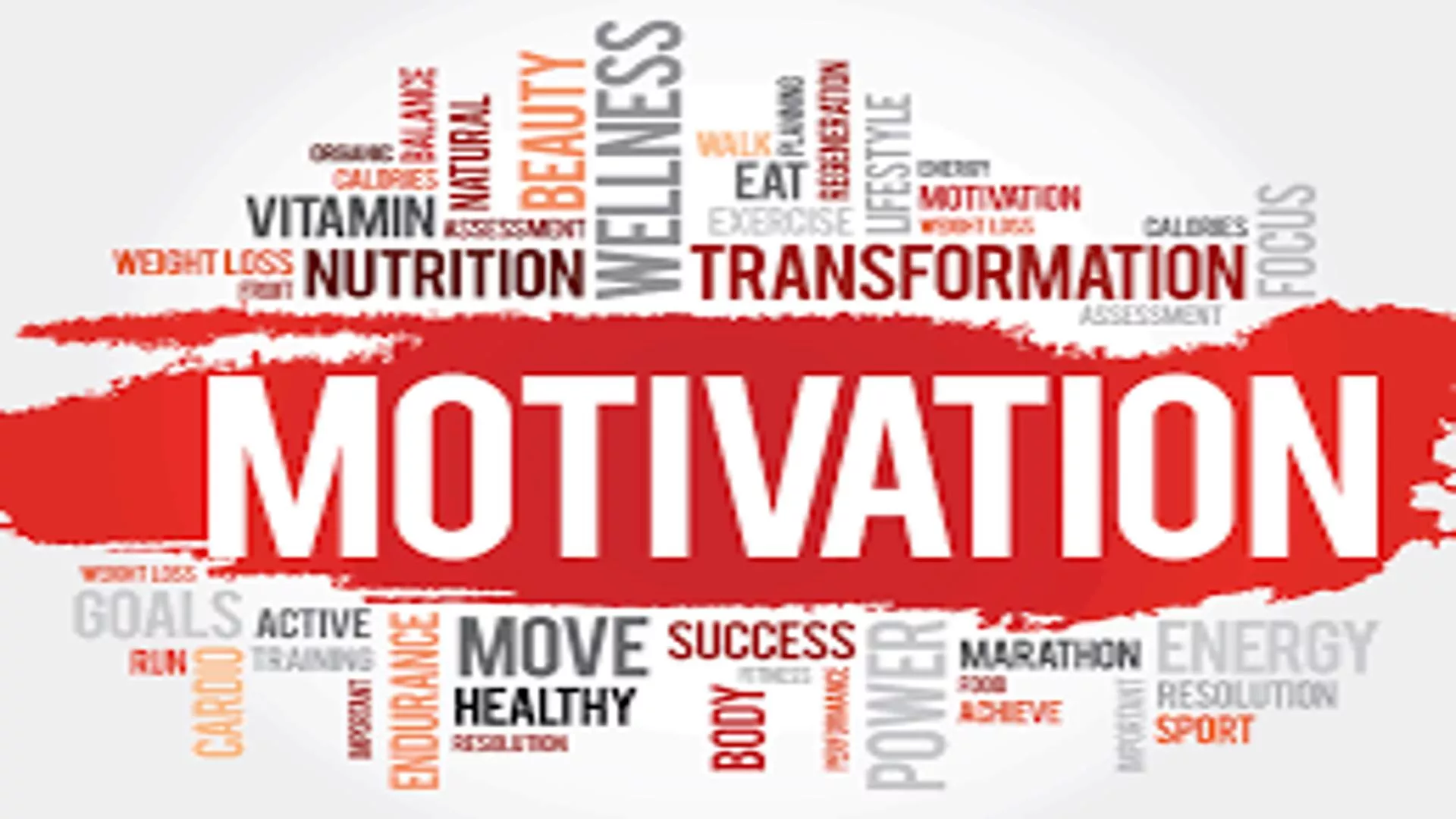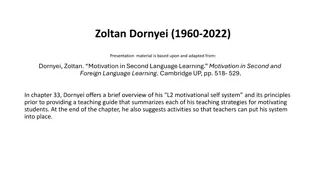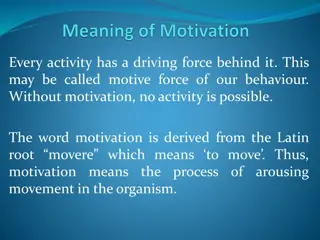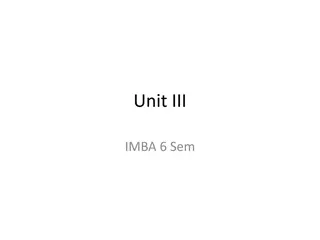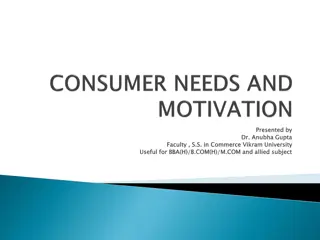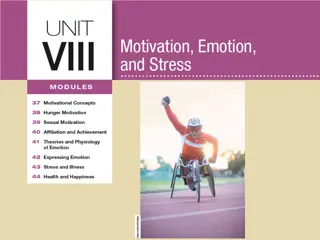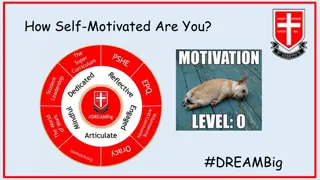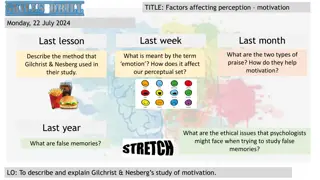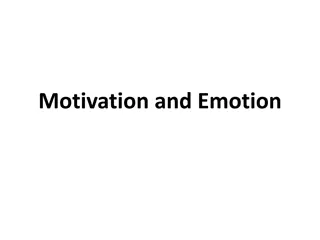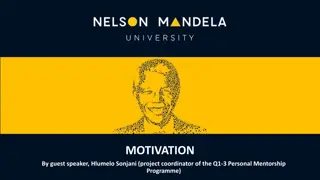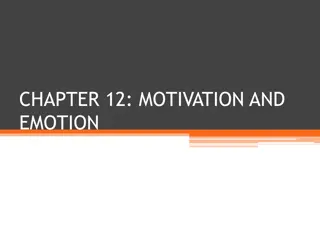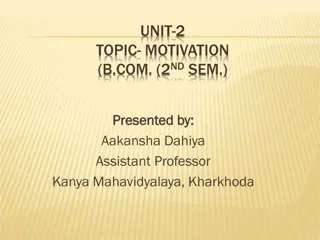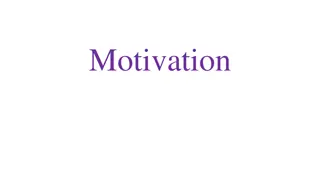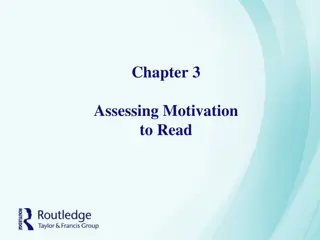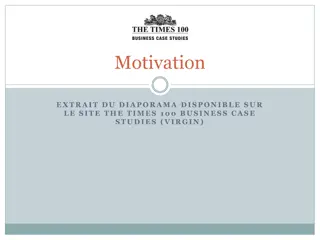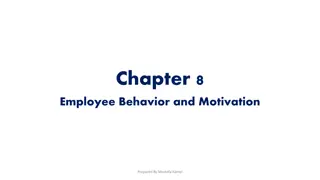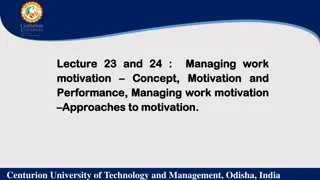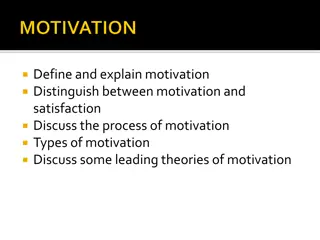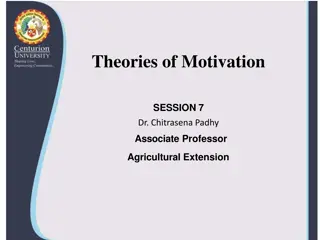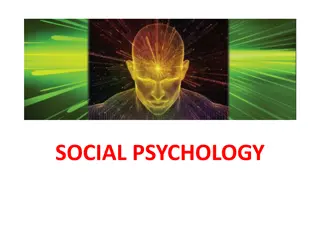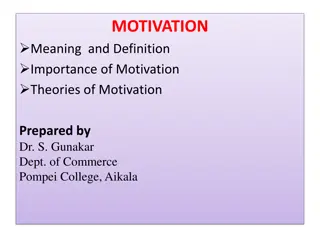Understanding Motivation and Its Types
Motivation, as defined by Zainab Khalid, a clinical psychologist, is the driving force behind goal-oriented behaviors. This article explores the components of motivation, different types of motives including primary and secondary motives, and various theories of motivation such as instinct theory and drive-reduction theory. By delving into the intricacies of motivation, one can gain insights into what energizes, directs, and sustains behavior towards achieving desired goals.
Download Presentation

Please find below an Image/Link to download the presentation.
The content on the website is provided AS IS for your information and personal use only. It may not be sold, licensed, or shared on other websites without obtaining consent from the author. Download presentation by click this link. If you encounter any issues during the download, it is possible that the publisher has removed the file from their server.
E N D
Presentation Transcript
Motivation and its types Zainab Khalid (Clinical psychologist)
What is motivation? Motivation is defined as the process that initiates, guides, and maintains goal-oriented behaviors. Motivation is a need or desire that energizes behavior and directs it towards a goal.
Components of motivation Activation involves the decision to initiate a behavior, such as enrolling in a particular class. Persistence is the continued effort toward a goal even though obstacles may exist. An example of persistence would be taking medicine in order to earn a degree although it requires a significant investment of time, energy, and resources. Intensity can be seen in the concentration and vigor that goes into pursuing a goal. For example, one student might pass without much effort, while another student will study regularly, participate in discussions, and take advantage of research opportunities outside of class. The first student lacks intensity, while the second pursues his educational goals with greater intensity.
Motive A energizes, moves directs towards the goals. motive is actuates, (Hence or channels an inner state that activates or motivation), the that behavior
Types of motives Primary motives General motives The competence motive Secondary motives Power motive The achievement motive The affiliation motive
Instinct theory Instincts are complex behaviors that have fixed patterns throughout different species and are not learned (Tinbergen, 1951). For example a woman builds different kinds of houses, the bird builds only one kind of nest.
Drive-Reduction Theory When the instinct theory of motivation failed to explain most human motivation, it was replaced by the drive-reduction theory. A physiological need creates an aroused tension state (a drive) that motivates an organism to satisfy the need (Hull) Drive reduction behaviors e.g eating, drinking etc Need e.g food, water etc Drive e.g hunger, thirst
Optimum Arousal Human motivation aims to seek optimum levels of arousal, not to eliminate it. Young monkeys and children are known environment in the absence of a need-based drive. to explore the
Herzberg's two-factor theory Fredrick Herzberg two-factor theory concludes that certain factors in the satisfaction (motivators), while others (hygiene factors), if absent, lead to dissatisfaction but are not related to satisfaction. The name hygiene factors is used because, like hygiene, the presence will not improve health, but absence can cause health deterioration. The factors that motivate people can change over their lifetime. Some claimed motivating factors (satisfiers) were: Achievement, responsibility, advancement, and growth. Some hygiene factors (dissatisfiers) were: company policy, supervision, working conditions, interpersonal relations, salary, status, job security, and personal life. workplace result in job recognition, work itself,
Hierarchy of Needs Abraham Maslow in 1970 suggested that certain needs have priority over others. Physiological needs like breathing, thirst, and hunger come before psychological achievement, self-esteem, and the need for recognition. needs such as
Types of Motivation Intrinsic motivation Extrinsic motivation
Intrinsic motivation The act of being motivated by internal factors to perform certain actions and behavior is called Intrinsic Motivation. There is neither pressure nor any sort of reward for the actions you perform due to intrinsic motivation. It can take the form of motivation by the work itself when individuals feel that their work is important, interesting and challenging and provides them with a reasonable degree of autonomy (freedom to act), opportunities to achieve and advance, and scope to use and develop their skills and abilities.
Extrinsic motivation In this type of motivation, the motives originate from outside the human body. The driving force exists outside the human body that stimulates the individual to perform certain actions. Though these motives are external to human body but they have rewarding or punishing impact on the individual.
Examples of extrinsic motives Incentives Bonuses Allowances Promotion Rewards and punishments Distinction certificates Appreciation certificates Prizes
References https://www.yourcoach.be/blog/wp- content/uploads/2012/03/A-summary-of-motivation- theories1.pdf https://www.researchgate.net/publication/306255973_ Motivational_Theories_-_A_Critical_Analysis https://www.tankonyvtar.hu/hu/tartalom/tamop412A/ 2011-0023_Psychology/030300.scorml








